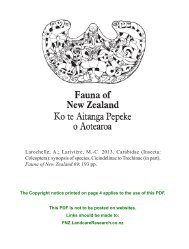Fauna of NZ 45 - Landcare Research
Fauna of NZ 45 - Landcare Research
Fauna of NZ 45 - Landcare Research
Create successful ePaper yourself
Turn your PDF publications into a flip-book with our unique Google optimized e-Paper software.
<strong>Fauna</strong> <strong>of</strong> New Zealand <strong>45</strong> 19<br />
—Larger, 2.3 mm or over. Segment 2 <strong>of</strong> antennal club longer<br />
than wide. Rostrum in lateral view gently curved in<br />
male, nearly straight in female. Male: eyes strongly<br />
convex; tibiae slenderer, not distinctly incurved at apex;<br />
tegmen with wider parameres,with parameral sector<br />
not as deeply notched; aedeagus 0.12–0.13 mm wide,<br />
with main body 4x longer than wide, with apodemes<br />
about three-quarters length <strong>of</strong> aedeagal body, with<br />
sclerites in the internal sac larger (Fig. 40). Length 2.3–<br />
2.7 mm. Subalpine in Taupo, Mid Canterbury .........<br />
.......................................................... (p. 21) ... halli<br />
Rhinorhynchus rufulus (Broun)<br />
Fig. 1, 19, 20, 27–33, 43–<strong>45</strong>, 168, 169; Map 1<br />
Broun, 1880: 467. —Voss, 1922: 13, fig. 4 (Rhinomacer);<br />
1932: 72 (Listrorhinus). —Tillyard, 1926: 244, fig. R77.<br />
—Hudson, 1934: 146. —Crowson, 1953: 242 (syn.<br />
zealandicus); 1955: 158. —Kuschel, 1983: 501, fig. 1–<br />
4; 1990: 3, 35, 69, fig. 76, 163. —May 1993: 28, fig.<br />
23–32 (larva).<br />
zealandicus Sharp, 1882: 89. —Voss, 1922: 19, fig. 8, 9;<br />
1932: 106.<br />
Reddish brown or dark brown, femora and tibiae usually<br />
yellowish red. Pubescence longer and denser than in other<br />
species, particularly on elytra where hairs are coarse,<br />
subsquamiform (stramineous), mostly somewhat golden<br />
(Fig. 1).<br />
Head as in Fig. 19, 20; temples strongly constricted;<br />
frons in both sexes densely and more coarsely punctate<br />
than in other species; rostrum in male moderately converging<br />
apicad towards antennal insertions, densely, rather coarsely<br />
punctate, with a fine, low median carina, with pubescence<br />
directed basad; rostrum in female weakly curved, gently<br />
converging towards antennal insertions, shiny on sides,<br />
with a fine, sparse to moderately dense punctation.<br />
Mandible (Fig. 28) nearly evenly curved on outer margin.<br />
Antennae extending to eyes with segment 4 in both sexes.<br />
Prothorax distinctly longer than wide in male, slightly wider<br />
than long in female, with dense, distinctly coarser<br />
punctation than in other species. Elytra seemingly<br />
multistriate on basal third or half owing to row <strong>of</strong> coarse<br />
puncta, these puncta as coarse as those in striae.<br />
Male. Parameral sector as in Fig. 33. Aedeagus (Fig.<br />
31, 32) with apex broadly and rather deeply emarginate.<br />
Length 1.5-2.7 mm.<br />
Types. (1) Rhinomacer rufulus Broun. Described from ‘one<br />
mutilated specimen’ from Tairua, Coromandel. Seven specimens<br />
bearing this name in Broun Collection <strong>of</strong> The Natural<br />
History Museum, London are from Mt Egmont, Wellington,<br />
Pakarau, and Taieri: none is from Tairua. The Broun<br />
Collection at <strong>Landcare</strong> <strong>Research</strong>, Auckland contains sev-<br />
eral specimens <strong>of</strong> this species identified by Broun, but<br />
again none from Tairua. A specimen from Wellington in the<br />
Broun Collection is chosen as neotype to replace the lost<br />
holotype, so as to assure correct and consistent application<br />
<strong>of</strong> the name in the future. Neotype &, 2.2 x 0.9 mm,<br />
Wellington, 829 [green], BMNH.<br />
(2) Rhinorhynchus zealandicus Sharp. Holotype %,<br />
2.20 x 0.85 mm, Greymouth, Helms, BMNH.<br />
Material examined. North Island. ND. Waipoua SF;<br />
Waimatenui; Paihia, Opua SF; Ngaiotonga; Parua. AK.<br />
Lynfield, Tropicana Drive; Lynfield, Wairaki Bush;<br />
Titirangi Res; Titirangi; Waitakeres; Huia; Manurewa,<br />
Murphys BushManurewa, Olive Davis Res; Clevedon;<br />
Manukau Peninsula, Awhitu Central, Kemps Rd. CL.<br />
Kakatarahae; Kauaeranga Valley. WO. Mt Pirongia. BP.<br />
Mamaku Plateau, Horohoro SF, Tikitiki Stream; Rereauira<br />
Swamp; Waiaroho. TK. Pouakai Ra, Summit; Pouakai<br />
Trig; Pouakai Ra; Mt Egmont. TO. Karioi; Ruapehu–<br />
Tongariro; Tongariro NPRuapehu, Tk to Taranaki Falls;<br />
Ruapehu, Whakapapa; Ruapehu, Iwikau; Ruapehu, Silica<br />
Springs; Ohakune; Ohakune Mt Rd, Makotuhu Flat. GB.<br />
Waimata V; Mt Hikorangi; Gisborne, Greys Bush. HB.<br />
Kaweka Ra, Makahu Spur. RI. Ruahine Ra, Triplex Spur;<br />
Taihape, Oraukura Gorge. WI. Fielding, Mt Biggs Rd.<br />
WN. Tararua Ra, Dundas Ridge; Tararua Ra, Waikanae<br />
Mtns, Kapakapanui; Wiltons Bush. South Island. SD.<br />
Kenepuru Sounds, Ft Mt Stokes. NN. Wairoa Gorge; 9<br />
miles N Karamea; Dun Mt; Wairoa V; Rough I, Rabbit I;<br />
Whangamoa; Totaranui, Pigeon Sdle, Lookout Rock;<br />
Waimea West, Eves Valley, Palmers Bush; Nelson,<br />
Wakefield; Baigents Bush; Mangarakau; Collingwood, ft<br />
<strong>of</strong> Mt Burnett; Collingwood, Kaituna R. BR. Paparoa Ra,<br />
Buckland Peaks; Paparoa Ra, Lochnager Ridge; Rapahoe;<br />
Mawhera SF, Tutty Plateau, Red Jacks Creek. WD. South<br />
Westland. MB. Pelorus Bridge. KA. Kaikoura, Rakautara.<br />
NC. Arthurs Pass. MC. Kaituna, Banks Peninsula; Mt<br />
Hutt, 1000 m. MK. Cook Ra, Mt Wakefield; Cook Ra,<br />
Ball Ridge; Sealy Ra; Kea Point track; Sealy Ra, Hooker<br />
V; Hooker Valley, Hoophorn Stm; Mt Sebastopol. OL.<br />
Dart Hut. CO. Kinloch, Wakatipu; N end Pisa Ra. DN.<br />
Dunedin; Mt Cargill. SL. West Plains; Invercargill;<br />
Invercargill, Thompsons Bush; Longwood; Longwood Ra,<br />
Grassland Smt; Longwood Ra, Orepuki Tk; Pounawea, E<br />
<strong>of</strong> Owaka. SI. Stewart I, Little River; Mt Rakeahua;<br />
Rakeahua V; Pegasus, Mt Anglem; Big S. Cape I, SW<br />
Stewart I; Codfish I, Sealers Bay. 565 specimens — see<br />
Appendix 2 for details <strong>of</strong> specimens examined.<br />
Distribution. North Island, South Island, and Stewart Island.<br />
Common all the way from sea-level to the subalpine
















